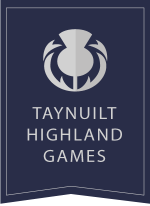Let the highland dancing begin...
Trophies
The Dugald MacCallum Memorial Cup
The Taynuilt Games Cup
The Taynuilt Games Shield
The Taynuilt Hotel Cup
The Brander Lodge Quaich
The Piper Alex Martin Shield
The Dhurinish Challenge Cup
The Etive Quaich
The Dances
THE HIGHLAND FLING
The Fling, the most famous of our Highland dances, is said to originate from the antics of a courting stag on a Scottish hillside. A shepherd was teaching his grandson to play the chanter (the first step towards learning the bagpipes) when they saw a stag leaping and turning his majestic antlers on the skyline. The shepherd asked the boy if he could imitate it. The boy copied the movements of the stag with his hands raised antler-like, springing and turning with feet raised to the knee one after the other. He practised these steps faithfully and when his father returned from the wars, he danced for him and so it is said the Highland Fling was born.
THE SWORD DANCE
The Sword Dance or “Gille Calum” in Gaelic, is Scotland’s oldest dance. It demands a strong performance, neatness in crossing the blades and precision in turning. It is said the original Gille Calum was Malcolm Canmore, a Celtic Prince who fought a battle in 1054. He killed his opponent, took his sword, crossed it with his own and danced over them in joy. Another tale has it that the swords were made red hot and every time the dancer touched them with his bare feet he howled in pain – causing the piper to blow even harder to drown the noise.
SEANN TRIUBHAS (Old Trews)
This beautiful and graceful dance is said to be a reminder of the days after the Jacobite Rebellion of 1745 when the National Government of the day believed that the banning of the bagpipes and the kilt would destroy the clan culture and lead to integration into the United Kingdom. The Seann Triubhas is a dance of this era done in tews or trousers. The shaking movements of the leg are said to represent the shaking off of the trews and the oppressor’s yoke.
THE REEL OF TULLOCH
Better known as the “Hullachan”, this dance is said to have originated on Deeside in a churchyard at the Tullich. When the minister failed to appear one Sunday in winter, the congregation stamped their feet and chafed their arms, freezing from long waiting. The mingling clapping and stamping eventually gave way to dancing which was formalised in time and called the Reel of Tulloch. Although the dancers dance in fours they are not judged as a team but individually.
SAILOR’S HORNPIPE
Although we look on the Games as an expression of Scottish culture, we are not afraid to import tradition if it is good. This dance originated south of the border and simulates the many typical shipboard activities common in the days of wooden ships and iron men.
IRISH JIG
Another very popular import is the Irish Jig, performed in the traditional green and red costume, based on traditional Irish steps but with arm movements added. Two of the tunes to which it is danced – “Paddy’s Leather Breeches” and “The Irish Washer Woman” gives credence to the story that Paddy gave his favourite leather breeches to a washer woman for cleaning. When danced by ladies, they are portraying the washer woman’s spirited reaction to this attack on their professional competence.
FLORA MacDONALD'S FANCY and THE SCOTTISH LILT
These dances are among a group of Scottish National Dances now being performed at Highland Games.The Aboyne dress which is worn is based on peasant costume of the 17th. century and lends itself to a more elegant type of dance.The costume is short enough to allow the leg movements to be judged.
Highland Dancing Entry Form Click here
